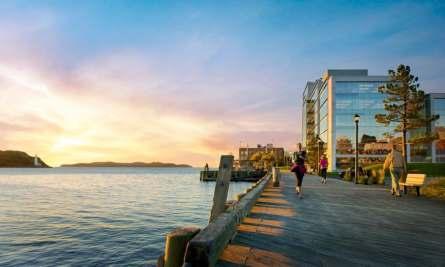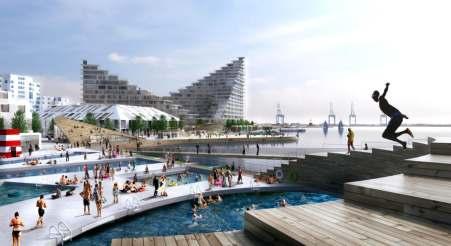
4 minute read
UNIT I: PRELUDE
Introduction
1.1 Introduction to Waterfronts
Advertisement
Development of a waterfront area with the aim of connecting and integrating the city with water. Waterfronts are settlements or civilizations or commercial developments that come up along the water body. Waterfronts are dynamic and unique places where the land and water meet. It is the interface of the aquatic and terrestrial. A waterfront zone is where interaction happens between the urban and the water. By being an interface between land and water, the waterfront zone is an area endowed with special characteristics. Waterfront is a zone of interaction and the waterfront area is considered to be a unique and irreplaceable resource where it interfaces between the land and water.

Water is a defining force that fundamentally shapes the character of each place it touches. It's a feature to be celebrated and honoured. Urban waterfronts, like the cities help define, dynamic places. Waterfronts are often the most valuable resource of a city. Also cities seek a waterfront zone that is a place of public enjoyment, ample visual and public access- to both the water and the land. These https://www.google.com/search?q=waterfront&rlz=1C1CHBF_enIN836IN836&source=lnms&t bm=isch&sa=X&ved=0ahUKEwim3oqgkLvjAhXz4nMBHVD9DzAQ_AUIESgC&biw=1366&bih=60 8#imgrc=gkulnAilSxZlZM: waterfronts have the potential to become the cultural and heritage hubs of the city that lie on the banks or shores of the waterfront as well as attract people from the city and also tourists.
Over recent decades, waterfront development and redevelopment has evolved and taken on its own identity in areas such as historic preservation and recreation. Creating minimum avenues for recreation and green open spaces. Also today many waterfronts are a staple of modernism, city beautification and helps in tourism.
1.2 Aim
This thesis highlights those lessons and considers how to create a city's identity and also to understand and develop an approach towards waterfront city. Transforming it into a unique platform with recreational and entertainment facilities serving the city and its people. Also it rejuvenates urban life, by improving the quality of life. The idea is to create an economically vibrant and safe and inclusive waterfront providing the best social and physical infrastructure for its residents, businesses and visitors. Also, at developing the waterfront areas and to provide aesthetically pleasing and highly functional spaces and activities that encourages the city dwellers to experience the beauty and serenity of the waterfront. The thesis focuses on creating a vital and vibrant waterfront that https://www.google.com/search?q=waterfront+tourism&rlz=1C1CHBF_enIN836IN836&source
=lnms&tbm=isch&sa=X&ved=0ahUKEwj9jfG-jrvjAhWc6nMBHTuxC0IQ_AUIECgB&biw=1366&bih
=657#imgrc=Bzm56OE_9JKqfM: serves to unite the community and the visitors in a shared experience of the city. It develops the city as a major commercial and tourist sector. Establish it as a major tourism attraction center and a local identity. Link the community with the waterfront. Integrate public open spaces with more natural water edge, landscapes, parks.
1.3 Objective
A wide variety of people and interests are involved in waterfront development, and understanding these interests and planning for them can only help in the successful implementation of a waterfront project. There are many important reasons to develop new, and re-develop existing, waterfronts. Waterfronts are places to live, places to work, and places we enjoy recreating. People all over the world have been living with water for millennia, as a source of food, transportation, and harmony. In recent years, managing water has become a major political and social topic because of climatic events that have caught a lot of media attention. People have been questioning whether waterfront property should be promoted as a place to live, or whether giant walls should be built to protect people from advancing water levels anticipated by climate change experts.

To demonstrate the significance of the waterfront, in the classic phrase, American anthropologist Loren Eiseley said, “If there is magic on this planet, it is contained in water, water is a fundamental attraction in all cultures”.
This study deals with the waterfront developments through the perspective of tourism and recreation and investigates the waterfront development through the available research examples in the world to formulate the design criteria as a theory of urban waterfront design.
1.3 What is the need of these Spaces?
Waterfront development can include any combination of dierent land uses, and waterfront projects can be new projects or re-developments of existing waterfronts into new places. Some waterfront projects focus on industrial uses, such as industrial ports, and others focus on more recreational and tourism-oriented uses. It's important that a diversity of uses can occur along a waterfront, bringing in as many interests as possible to the waterfront, but it's not necessary that a diversity of uses occurs within each project. For example, due to environmental, public safety and security reasons, it may not be appropriate to locate a public park and residential neighborhood within the same zone as an industrial port.
Figure 3: Waterfront Uses
The waterfront development is needed as it promotes the waterfront activities at strategic locations with major water views and create activity nodes and destinations where possible. Thus also providing diversified opportunities for dierent functions and promoting the waterfront front vitality both day and night. The importance it holds in maximizing the amenity value of sites with good natural settings by promoting mixed use development with public oriented activity and creating focal points and activities nodes. It also promotes retailing and leisure activities to the water edge. Promote integration of waterfront recreation areas with adjoining land uses in terms of pedestrian, access and landscape design frameworks. by building a Sense of Place. The need of the waterfront is essential to protect the waterfront's historic values and its significant historical structures and landmarks which should always be preserved or conserved.

Any building on the waterfront should boost activity in the public spaces around it. Ideally, there should be a mix of uses, with seamless interaction between inside and outdoors. High-rise towers that lack any public uses on the ground floor are noticeably out of place along rivers, lakes and ocean fronts. They usually create a wall that physically and psychologically cuts o the waterfront from surrounding neighborhoods.
https://www.google.com/search?rlz=1C1CHBF_enIN836IN836&biw=1366&bih=657&tbm=isch &sa=1&ei=Kbg_XYnxDs_orQHG1JPoCQ&q=waterfront+city&oq=waterfront+city&gs_l=img.3.. 0l10.25208.28706..28830...1.0..0.341.1270.0j5j1j1......0....1..gws-wiz-img.......0i10i24j0i8i30j0i24.yg08 g9WdkOw&ved=0ahUKEwjJqc2-2NvjAhVPdCsKHUbqBJ0Q4dUDCAY&uact=5#imgdii=ahEZwd YCXcf5FM:&imgrc=2YGRWcg6DuaPBM:








